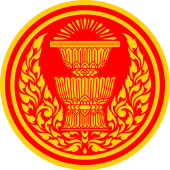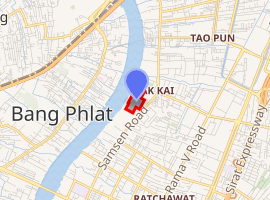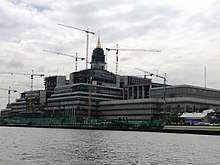Sappaya-Sapasathan
The Sappaya-Sapasathan (Thai: สัปปายะสภาสถาน, RTGS: Sappayasaphasathan, pronounced [sàp.pāː.já(ʔ).sā.pʰāː.sā.tʰǎːn]) currently houses the National Assembly, the legislative branch of the Government of Thailand. The legislature is a bicameral body, consisting of two chambers: the upper house, (the Senate of Thailand), and the lower house, (the House of Representatives of Thailand).[1] It is the third parliament house of Thailand, replacing the original Parliament House of Thailand near Dusit Zoo. The project was initiated in July 2008, when Samak Sundaravej became Prime Minister.[2]
| Sappaya-Sapasathan | |
|---|---|
สัปปายะสภาสถาน | |
 | |
.jpg) The new parliament house of Thailand, viewed from Bang O MRT station. | |

| |
| General information | |
| Architectural style | Buddhist-inspired, Modern |
| Town or city | Kiakkai, Thanon Nakhon Chai Si, Dusit, Bangkok |
| Country | Thailand |
| Construction started | 8 June 2013 |
| Completed | Late-2020 |
| Client | National Assembly of Thailand (2019–present) |
| Technical details | |
| Floor area | 424,000 m2 |
| Grounds | 300,000 m2 |
| Design and construction | |
| Architect | Theerapol Niyom |
| Website | |
| www | |
History
The parliament has changed its venue on a couple of occasions. Its first site was Ananta Samakhom Throne Hall, used from 1933 until 1974. It then moved to the Parliament House of Thailand, but the building was soon outgrown. In 2008, three sites were considered for a new building. They were the Dusit District, the Mueang Nonthaburi District, and the Khlong Toei District. The Dusit District was chosen by Samak Sundaravej government.[3]
Name
There are slightly different interpretations of the building's name:
The title of the winning design was Sappaya Sapha Sathan. The architects who submitted it said that the Buddhist term sappaya means 'comfortable in dharma', and the title is supposed to mean "a place for doing good deeds or good karma".[4]
The building's design was inspired by a classic Thai Buddhist tale, Trai Bhum Phra Ruang, and was made to look like a temple as a reminder to officials of "Thainess" and morality, making it truly a Sappaya Sapasathan, 'peaceful parliament'.[5]
Sappaya-Sapasathan is a word combination with sappaya or the seven of Sappaya meaning 'comfortable', 'conducive conditions', 'supportive', and the 'right thing'[6] and the word sapasathan meaning 'council of the peaceful'.
Design
The Sappaya-Sapasathan design by a team led by Theerapol Niyom was the winner in a new parliament building design competition.[4] Built to provide more than 424,000 m2 of floor space, at a budget of approximately 12 billion baht, it can accommodate more than 5,000 persons and parking for 2,000 automobiles. Its main features are a Thai pagoda in the center of the building, Suriyan Hall (Hall of the sun) for House of Representative, Chantra Hall (Hall of the moon) for Senate and the use of 5,018 teak trees as they represent the "DNA of Thailand".[7] It also houses museums, a convention center, a seminar room, a banquet hall, and offices. The design has been criticised for being "religious architecture", embracing "elements of Buddhist and Hindu cosmology".[8]
Construction

The new parliament building, after significant delays, is due to be inaugurated in late-2020.[8] It was contracted for in 2013 and was scheduled to be opened in 2015. It sits on a bank of the Chao Phraya River in Kiakkai neighbourhood of the Thanon Nakhon Chai Si Subdistrict, occupying 300,000 m2 of land. The site of the current parliament building was returned to its owner, the Bureau of the Royal Household, at the end of 2018.[9] Construction of the new building has been delayed for four years. The project budget has ballooned from 14 billion baht to 23 billion baht.[8] Parliament has levied no penalties on the developer for missing the deadline. As the land where the old parliament building sits was already returned to the Crown Property Bureau, Parliament met in an auditorium rented from telecom firm TOT at a cost of 11 million baht per month from May 2019.[10] Since August 2019, Parliament now meets in Sappaya-Sapasathan, although parts of the building remain unfinished.[11]
See also
| Wikimedia Commons has media related to Sappaya-Sapasathan. |
- National Assembly of Thailand – Legislature of Thailand
- Senate of Thailand
- House of Representatives of Thailand
- Ananta Samakhom Throne Hall – Previous home of the National Assembly (1933 - 1974)
- Parliament House of Thailand – Previous home of the National Assembly (1974 - 2018)
- Government House of Thailand – Home of the executive branch of the Royal Thai Government
References
- "รัฐสภาแห่งใหม่ (สัปปายะสภาสถาน)แลนด์มาร์ค ริมเจ้าพระยา". Realist.
- "สัปปายะสภาสถาน". King Prajadhipok's Institute. Retrieved 8 June 2019.
- "ความเป็นมาของโครงการ".
- "Design of new parliament focuses on morality in politics". Pratchatai English. 2009-12-15. Retrieved 2018-12-06.
- "A 'symbol of Thainess': Thousands of teak trees to be cut down for Thailand's new parliament building". Asian Correspondent. 2016-07-26. Retrieved 2018-12-06.
- ความหมายของสัปปายะ.
- Mokkhasen, Sasiwan (2016-07-25). "No, 2,000 Teak Trees Won't Be Cut For New Parliament – More Like 5,000". Khaosod English. Retrieved 2018-12-06.
- Phataranawik, Phatarawadee (8 June 2019). "Bless this house". The Nation. Retrieved 8 June 2019.
- "NLA seeks temporary venue for parliament". Bangkok Post. 2018-12-06. Retrieved 2018-12-06.
- "The Stupidity Has to Stop" (Opinion). Bangkok Post. 24 April 2019. Retrieved 3 June 2019.
- "รัฐสภาใหม่ "สัปปายะสภาสถาน" เปิดใช้แล้ว แต่ไม่พร้อม ก่อสร้างและตกแต่งไม่เสร็จหลายจุด" [New parliament building "Sappaya-Sapasathan" now opened but unready; Construction and furnishing still unfinished at many points.]. Workpoint News (in Thai). 7 August 2019. Retrieved 25 August 2019.